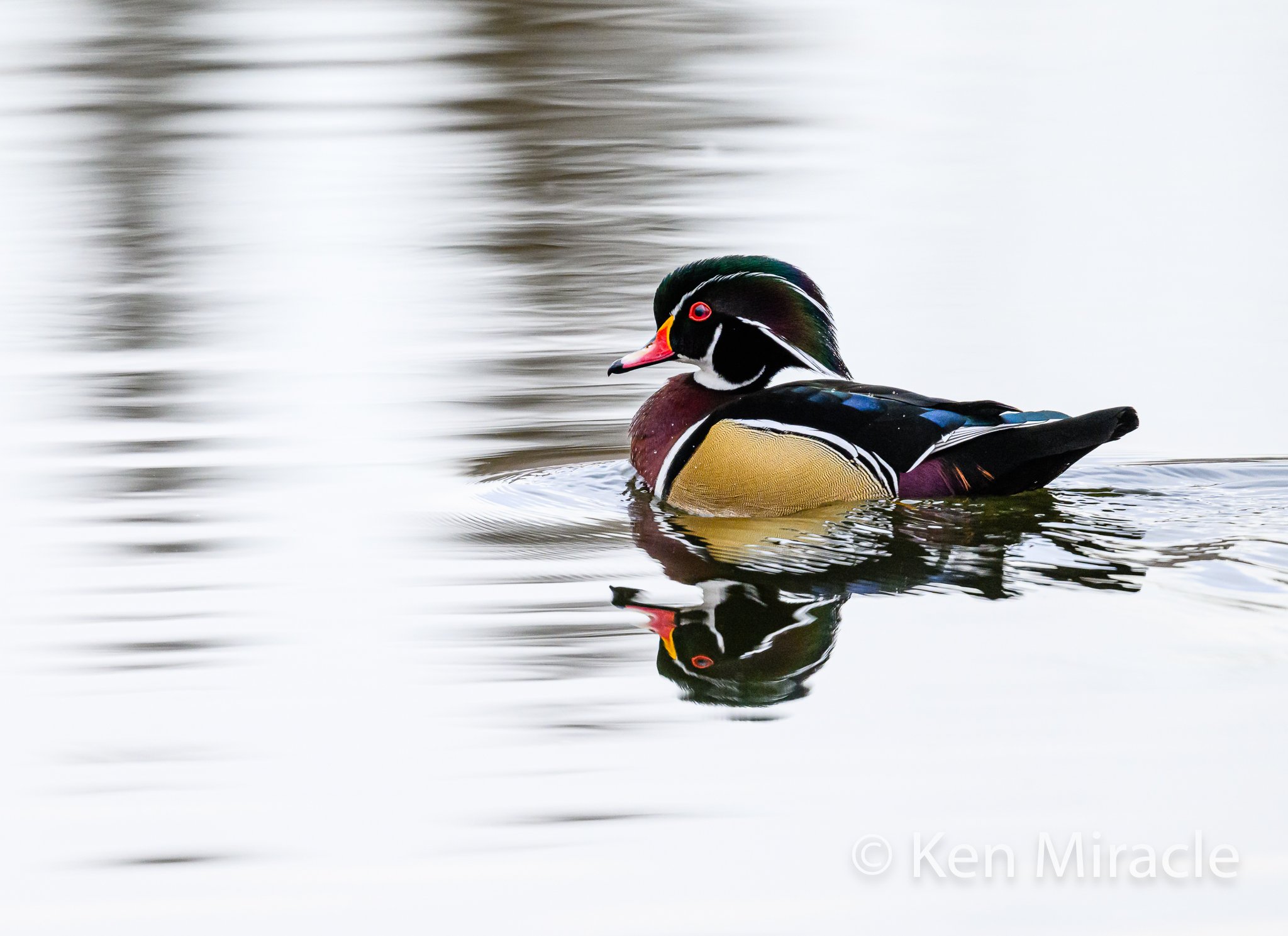Paint-by-Number Duck
By Debbie Wiggins, Golden Eagle Guest Blogger
The Wood Duck (Aix sponsa) is one of the favorite ducks of our friend Claire because they remind her of the paint-by-number art that she (and many of us) created as kids. It would, however, take more than your basic set of crayons to color the Wood Duck - dark green, blue, purple, rust, brown, white, buffy, red, black, gray, bronze, cyan. Their patterns defy description.
Male Wood Duck by Ken Miracle
Word in the Marsh
The female, as usual, is less colorful than the male—think camouflage. As she skulks in low-light conditions beneath branches overhanging still water, her grayish body makes her difficult to see. The white bridle and teardrop-shaped eye ring may tip off her identity. Get this: It has been discovered that the size of the white eye ring is a tipoff to the male of her breeding potential. A larger eye ring is an age-related indicator of reduced fitness and fertility…the word in the marsh - hell to get old.
Wood Ducks by Ben Gundy
Amazingly, even the stunningly colorful male gains camouflage through the phenomenon of disruptive coloration. The elaborate colors, the various lines and stripes that create his beautiful pattern break up his recognizable duck shape, throwing off predators and birders alike.
I’ve Got the Bill For That
There are many well-known avian acorn lovers: jays, grackles, woodpeckers, brown thrashers, tufted titmice, wild turkeys, and Wood Ducks. Wood Ducks?! For all the reasons other birds eat them, adult Wood Ducks gorge on acorns in the fall and winter. They are high in fat content, suitable for winter survival and pre-breeding/laying/nesting. Wood Ducks have shorter, narrower bills than most other dabbling ducks. The maxillary (upper) bill ends in a downturned point that looks a bit like an egg tooth but isn’t. This lets them pick up acorns (which they swallow whole), snip aquatic plants and grab small invertebrates. Their omnivorous diet, of course, varies with season and life phase.
Wood Ducks by Ken Miracle
Tree Climbing Duck
Once paired, Wood Ducks remain monogamous for one season. They are the only North American duck that regularly produces two broods each breeding season. This improves chances for reproductive success. The Wood Duck is the ‘poster duck’ of cavity nesters. They have sharp toenails on their webbed feet which stabilize them on tree branches and help the hen to climb in and out of the nest. The male accompanies her while she examines the cavity ‘contenders’, but she has the final say-so in nest selection.
The most commonly chosen site is in a tree trunk where heart rot has caused a branch to break away, but a cavity previously occupied by a pileated woodpecker will work, and so will an artificial nest box. Unlike many other duck species, the male continues to stay with the female, but he never enters the nest. She lays an egg a day while he waits outside, then they go about the rest of the day together. This routine continues until all the eggs (10-13) are laid. She begins to incubate the eggs, and he may remain nearby until only a few days before the eggs begin to hatch. Then he departs.
Leap of Faith
Several hours before the hatch, she begins to vocalize, a soft kuk kuk kuk. Twenty-four hours after the last hatchling emerges, the female leaves the nest briefly to make sure the coast is clear. If all appears well, she stands at the bottom of the nesting tree and utters the same soft kuk kuk kuk, coaxing the ducklings to her. Emerging, the little ones leap, drop, bounce, and pop to their feet, making their way to begin their lives in the water.
In the early 1900’s, Wood Ducks were at risk of extinction. Conservation efforts painted them back into the picture. Let us help them stay there.
Wood Ducklings by Ken Miracle
References
Cornell Lab of Ornithology, birdsoftheworld.org
Curtis, Paige, 10 Fun Facts about the Wood Duck, Audubon Magazine, December 13, 2023
BirdZilla birdzilla.com Wood Duck article by Heleen Roos, February 28, 2023
Stevens, Martin, Lost and Found: Abbott Thayer and the Study of Camouflage. abbottthayer.com
Next up: Common Goldeneye (Bucephala clangula)



